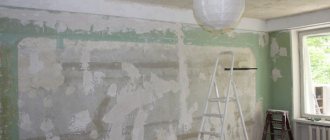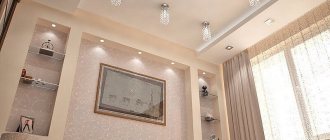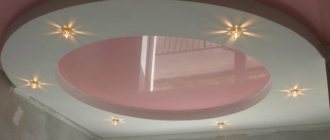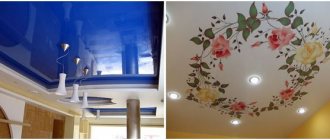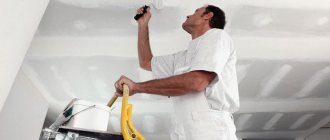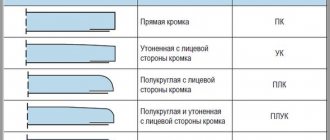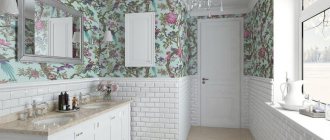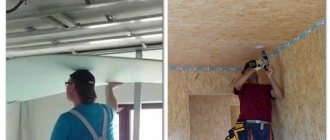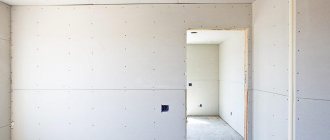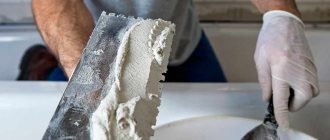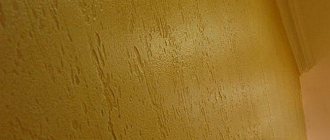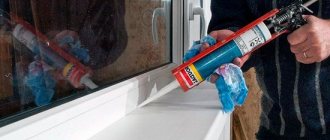Characteristics of drywall
Belongs to the group of composite materials, made from gypsum and cardboard and available in the form of slabs of different sizes. They produce moisture-resistant drywall, which can be used in rooms with high humidity. GKL sheets are an environmentally friendly material that retains its shape due to thick cardboard; It contains gypsum and additives that improve the properties of the material.
There is wall and ceiling plasterboard. They have different properties, so there is no need to use the plates for other purposes. If you plan to make a ceiling from plasterboard, you need to take into account that such sheets are thinner than wall sheets. This is the main difference. The thickness of the ceiling tiles is 9.5 mm. A separate category includes fire-resistant, moisture- and fire-resistant, arched (flexible) material.
When choosing, the shape of the sheet edges is also taken into account.
Material characteristics:
- bending strength: from 10 kg for gypsum plasterboard with a thickness of 10 mm;
- fire resistance: even standard sheets of material can withstand the effects of fire, and a special type retains its shape much longer when in contact with environments with extreme temperatures;
- the tendency to absorb moisture is high - the absorption rate is up to 10%, but upon contact with water the material loses strength;
- low thermal conductivity (up to 0.35 W/(M*K)) - savings on insulation, since gypsum board retains heat well;
- tensile strength - 30 kg/1 m²; if the intensity of the load increases, the plasterboard slab cannot withstand it.
Advantages and disadvantages
Positive traits:
- low price;
- ease of installation: when assembling plasterboard ceilings, complex equipment or special skills are not required, as, for example, in the case of tension structures;
- flat surface – costs for finishing the rough coating are reduced;
- versatility, gypsum board sheets are used for various tasks: delimiting space (multi-level ceilings), leveling the ceiling, etc.;
- it becomes possible to install lighting systems with any lamps (chandeliers, spotlights, spotlights, etc.);
- the material reduces heat loss through the ceiling, and the effect is enhanced by the air gap between the sub-ceiling and the gypsum board slabs;
- hiding wires behind a profile structure;
- after installation there is no chemical smell; the material is environmentally friendly, does not pose a health hazard even in difficult conditions (during combustion);
- moderate plasticity.
Flaws:
- the more complex the configuration, the more it will hide the space;
- the need for strict control of the work to ensure the alignment of the frame and slabs in order to avoid destruction of the ceiling in the future;
- hygroscopicity: if the humidity level is high, the structure will absorb excess water from the air, which will lead to deformation.
Installation rules - comparing technologies
Before passing a verdict on the ideality of a particular material, you need to consider their installation technology.
Installation of a stretch ceiling is as follows:
- the ceiling and walls are prepared (the walls must be smooth);
- the mounting plinth is attached around the perimeter of the room, on the walls;
- the canvas is fixed in the mounting plinth;
- the ceiling is stretched, for which it is exposed to hot air.
Important: The exception is fabric ceilings - they stretch mechanically, without heating.
Installation of a stretch ceiling
If we talk about plasterboard, then the installation is performed as follows:
- the ceiling is prepared: cleaned, treated with an antifungal agent;
- the surface for installation of the frame is marked;
- a profile frame is mounted;
- the frame is covered with plasterboard;
- drywall is puttied;
- finishing is carried out (wallpaper, paint).
One of the stages of installing a plasterboard ceiling
When comparing which ceiling is better in terms of installation, tension or plasterboard, we can highlight several nuances:
- Installation of a stretch ceiling is easier and faster (installation work is completed in just a few hours). However, this will require professional skills and special equipment, including a heat gun.
- Installing a plasterboard ceiling is possible with your own hands, without specific tools. True, in this case the work will take longer, because it will be necessary not only to assemble the frame and sheathe it, but also to putty and then paint the sheets - and between all these stages technological intervals must be maintained.
Vinyl stretch ceilings
When installing this structure, a material of increased elasticity is used. This property becomes more pronounced when heated. This is the basis for the installation principle of vinyl stretch ceilings. The material that is used is chosen taking into account the dimensions of the room. Thus, options from 1.5 to 5.2 m are available for sale. The standard size is 3.3 m. This fabric can be used to make a seamless ceiling (a seam can ruin the look and complicate the design).
To fasten the elastic material, a frame made of metal profiles is used. Considering that the film is characterized by relatively low strength, structural elements and lighting fixtures should be fixed on the rough floor, because vinyl will not withstand significant loads.
The coating is two-layer: vinyl is provided on top (thickness no more than 0.18 mm), the base is polyvinyl chloride. During production, additives are added to improve the properties of the film. The material belongs to the finishing group. It can be purchased in different colors. In addition, there are matte, glossy, satin varieties of coating.
Advantages and disadvantages of film
Positive traits:
- moisture resistance: the film does not lose its properties even in direct contact with water;
- resistance to fungi and mold;
- versatility: thanks to its properties, the coating can be used in premises for various purposes;
- high degree of elasticity;
- tensile strength: vinyl is not damaged if you pull it hard, it easily restores its shape;
- variety of colors and textures and sizes;
- installation does not take much time;
- you can create structures from several levels, combine different types of vinyl;
- easy care;
- long service life - several decades.
If you compare which is better: plasterboard or suspended ceiling, you need to take into account that the latter option lasts several times longer (the service life of gypsum plasterboard sheets is 10 years).
Disadvantages of vinyl structures:
- the upper maximum temperature limit is +50°C;
- It is not recommended to cool the film to +5°C, because under such conditions it cracks and begins to lose its properties;
- despite the material’s resistance to tensile loads, low strength under point loads (impact, puncture, etc.) is noted; it is impossible to restore the coating in case of such damage;
- Given exposure to high temperatures, do not use lighting sources that become very hot, such as incandescent or halogen lamps; the possibility of installing fluorescent or LED lamps should be considered;
- after installation, a specific smell of the film appears, which disappears during the first 2 weeks of operation;
- if you plan to install a suspended ceiling in a large room, you need to eliminate the risk of sagging of the elastic material.
Fabric stretch ceilings do not have many of the listed disadvantages.
Cost comparison
The last parameter in many situations is the most important: it is no secret that we are often forced to choose a finishing option based on its cost. Therefore, when comparing plasterboard and suspended ceilings, you need to take into account everything - the cost of materials, payment for the services of installation specialists, and the price of preparing the room.
As for materials, at first glance, a suspended ceiling made of plasterboard is cheaper than rather expensive suspended ceilings. Especially if we take into account stretch ceilings from famous brands.
However, there is one nuance here: the cost of materials for the construction of a suspended ceiling, as a rule, does not include the cost of its finishing. Those. A “bare” suspended ceiling covered with plasterboard will cost much less than a suspended ceiling. But if you take into account the cost of finishing materials, the picture can seriously change.
Stretch ceiling cost calculator
We talked about the second aspect at the very beginning: a plasterboard ceiling allows you to significantly save on installation. You can do this by installing the ceiling yourself. But to install a stretch ceiling, you will definitely have to contact installation specialists - at a minimum, to rent specialized equipment (heat gun, etc.)
Therefore, from the point of view of saving money, a suspended ceiling still looks preferable to a suspended ceiling.
Loss of altitude
When deciding which is better: suspended ceilings or plasterboard, the structures are compared by size. If you plan to use vinyl sheeting, then in this case the ceiling will be reduced by 35 mm. However, this result is obtained when the ceiling is level. If there are differences in levels around the perimeter of the room, you will need to additionally lower the structure to a height corresponding to the difference in levels.
Drywall hides more free space. For example, when using standard materials (profile - 27 mm high, sheet thickness - gypsum board 9.5 mm), there is a decrease in height by 40 mm (+/- several millimeters). In most cases, the value of this parameter increases to 10 cm, because thermal insulation is placed inside the structure or a multi-level ceiling is installed.
pros
The new modern material has quite a large number of advantages:
- Thanks to its unique properties, you can give your interior a bright and unique style. The vinyl film from which this ceiling is made takes on various shapes, colors or textures. Therefore, you will be able to create a beautiful pattern even on the ceiling;
- quick installation is a huge plus, because in a couple of hours you will get a completely new, luxurious ceiling;
- suspended ceilings tolerate wet conditions better than plasterboard;
- easy to care for, it will also help you in everyday life;
- Over time you can change the shape or design;
- Typically, the service life of the ceiling is twenty-five years;
- does not lose its attractive appearance and is not deformed at all.
Which one is faster to install?
In terms of installation speed, the tension option wins. To install it, prepare a frame, which is fixed under the ceiling. At the last stage, it is heated, the vinyl becomes more elastic, then it is tucked into a baguette. The total work time is up to 4 hours.
The plasterboard structure is assembled at different speeds, which is influenced by the degree of complexity of the ceiling. In most cases, the work takes 2 to 4 days to complete.
It is necessary to compare these options taking into account the installation method. For example, it is difficult to make tensile structures yourself if you do not have experience in performing such work. In this case, you will need assistants, as well as a heat gun, with which the vinyl is heated to give the desired shape.
Drywall is easier to install; standard tools are used; If the room is large, you will need help.
Canvases in operation - in which case is it easier?
During operation, plasterboard structures require minimal maintenance. On average, products last about 10 years.
Plasterboard ceilings most often have problems with seams, where the putty becomes unusable. The solution in such cases will be a small cosmetic repair with painting of the repaired areas.
If a room with plasterboard ceilings is flooded by neighbors from above, faulty heating systems or a leaky roof, you cannot do without replacing the damaged sheets.
Both fabric and “film” stretch ceilings require the simplest care. To maintain them in proper condition, it will be enough from time to time to carry out wet cleaning without the use of chemicals in the case of PVC film and dry cleaning with a vacuum cleaner in the case of fabric samples.
Flooding is not a problem for a stretch ceiling
It is especially worth noting what is good about suspended ceilings is their ability to withstand hundreds of liters of water in the event of a flood. Acting as a giant umbrella, the ceilings will prevent damage to property and will retain their original appearance after draining and drying.
Which to choose
A number of factors are taken into account:
- own capabilities: in the absence of experience, it is better to choose drywall if the structure will be installed independently;
- intended purpose of the room: vinyl is used in areas of high humidity;
- height of the room: the lower the draft ceiling is located, the more suitable a tension structure becomes in this case;
- operating conditions: take into account the type of lighting fixtures that are built into the ceiling, the average air temperature in the room (you must remember that vinyl does not tolerate strong cooling, and also loses its properties when overheated).
Combined ceilings
In this case, during installation, a frame made of a metal profile is used, onto which drywall is attached. The slabs are used to create a box for the purpose of further laying the vinyl sheet in the center.
The configuration of the plasterboard structure and elastic coating can be different; the choice is made taking into account preferences and operating characteristics. The combination of a glossy finish and gypsum boards allows you to create a complete composition. The design is attractive.
About design, texture and shape - which ceiling is better?
It’s easy to “play up” stretched and plasterboard sheets in such a way that the structures become more interesting and unusual. Drywall sheets, for example, can be coated with water-based paint, experimenting with colors and transitions.
In the case of PVC film, the possibilities are even brighter. Using special equipment and technologies, manufacturers produce a huge range of products of different colors, shades, factors, including photographs on custom-made canvases. The surface of such a ceiling can be:
- glossy;
- matte;
- semi-gloss;
- velvet;
- leather, etc.
Thus, it turns out that despite the possibility of excrement in both cases, suspended ceilings made of PVC film are more advantageous due to the wide variety of design solutions.
Stretch ceiling design option
